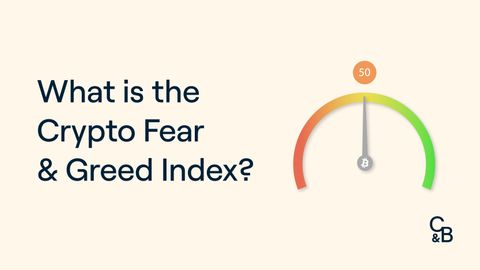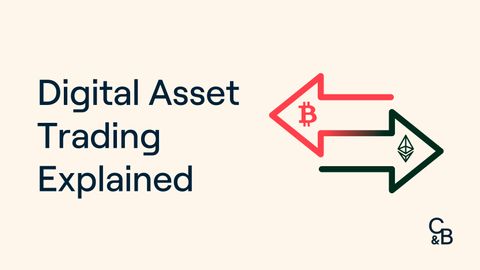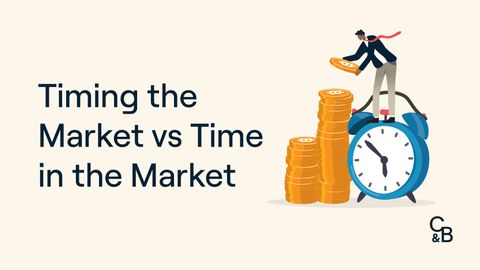In August 2025, the total cryptocurrency market capitalisation stands at almost US$3.95 trillion, following an all-time high of over US$4 trillion in July 2025. Considering that cryptocurrencies have only existed for approximately 15 years, these numbers are impressive and demonstrate the accelerating adoption of and capital allocation to crypto.
Without the context, though, what does the crypto market cap really mean? Is it an indicator of any historical trend, growth potential, or actual dollar amount?
Let’s dive into the most commonly touted crypto statistic: market cap. We’ll discuss what it really means, how it’s calculated, and how this metric could help you make decisions on future crypto investments.
- Definition:
- What is Market Cap in Crypto?
- How is Market Cap Calculated?
- Difference Between Small, Mid, & Large-Cap Cryptocurrencies
- Market Cap vs. Cash Inflow
- Other Metrics & Ways to Evaluate Cryptocurrencies
- Market Cap vs Volume
- Top 10 Cryptos by Market Cap**
- Market Cap FAQs
- Start Building Your Crypto Portfolio with Caleb & Brown
Definition:
In the crypto market, market capitalisation (market cap) is the total dollar value of all coins in circulation. Market cap can be used to measure the value of a specific cryptocurrency, as well as refer to the total capitalisation of all cryptocurrencies in existence.
What is Market Cap in Crypto?
Market cap is a metric used to help traders and investors understand the current or future value of a particular cryptocurrency. It’s a concept with roots in traditional investing, where market cap is used to quantify the dollar value of shares in circulation for a company.
The size of a market cap can help investors make inferences about the risk profile of a coin, its potential for long-term growth, and its market dominance.
How is Market Cap Calculated?
There are two common ways to express cryptocurrency market cap: circulating supply or fully diluted supply. Market cap can be calculated by using the number of coins currently in circulation (circulating supply). It can also be calculated using the number of coins that will be in circulation once the limit is reached (fully diluted supply).
Given that this serves mainly as a tool for making investment decisions in the present, circulating supply is almost exclusively used when calculating market cap. However, if you’re set to be a long-term holder, it’s worth considering the impacts of a fully diluted supply on your stake. Typically, a significant difference between the current market cap and fully diluted supply means that more tokens may be released to the market. This can place downward pressure on a cryptocurrency’s price.
Market cap based on circulating supply is calculated with the following formula:
Current Price x Circulating Supply = Market Cap
Difference Between Small, Mid, & Large-Cap Cryptocurrencies
When using market cap to discuss cryptocurrencies, they are generally divided into three categories: small, mid, and large-cap.
Small-cap cryptocurrencies
Small-cap cryptocurrencies tend to have market caps under US$1 billion. Compared to other coins, they usually have less exchange support, lower volume, or both. For this reason, small market movements can create volatile swings for these cryptocurrencies.
Mid-cap cryptocurrencies
Mid-cap cryptocurrencies have capitalisations between US$1 billion and US$10 billion. Traders often look to mid-cap coins to predict growth potential. Yet since these cryptocurrencies haven’t established large-cap positioning, there is still a greater level of risk involved.
Large-cap cryptocurrencies
Large-cap cryptocurrencies have market capitalisations of more than US$10 billion. These are your ‘household name’ coins, such as bitcoin, Ethereum, XRP, and more. These cryptocurrencies have a relatively higher trading volume compared to other crypto assets.

Why Are Large-Cap Cryptocurrencies Considered to Have Lower Risk Profile?
Cryptocurrency investments are often more volatile than stocks or other traditional investments. That said, investors see large-cap cryptos as relatively stable investments within a volatile market. The large-cap coins, which have shown growth over time (not overnight growth), usually have high liquidity, characteristics similar to the largest and long-standing publicly listed companies – stalwarts like General Motors, Ford and other multinational giants.
So if many investors decide to market and sell these larger assets at once, price and market cap drops will be smaller compared to a sell-off of small or mid-cap market assets.
Market Cap vs. Cash Inflow
Market cap and cash inflow are often confused because both are expressed in dollar amounts, but they represent very different concepts.
Market Cap is the total value of a cryptocurrency. It’s calculated by multiplying the current price of one coin by the total number of coins in circulation. It’s a snapshot of the coin’s overall value, not the amount of money that has been invested or is currently in the market. Cash Inflow, on the other hand, refers to the actual money being invested into the market: new funds coming in to buy the cryptocurrency.
A cryptocurrency’s market cap can change due to fluctuations in the coin’s price, even if no new money is entering or leaving the market. For example, if the price of a coin goes up, the market cap increases, but this doesn’t mean that more cash has been invested.
It’s important to recognise that market cap is not a direct measure of cash inflow. It simply reflects the current value based on price changes and the total supply of coins.
Other Metrics & Ways to Evaluate Cryptocurrencies
While market cap is important, you should never use this number alone to evaluate a potential investment. Below is a list of other things to consider while doing your research.
- What is the project solving? i.e. Is there utility?
- Do the values of this project align with my values?
- What is the overall project ranking?
- Read the project white paper, Is there anything about the project that seems questionable? (e.g. lack of real-world case use, issues with legality)
- What is the cryptocurrency’s price history?
- Does it have liquidity and high trading volume across different exchanges?
Further reading: The Bitcoin White Paper
Market Cap vs Volume
The relationship between market cap and volume can be speculative. Although one can influence the other in different ways, these influences aren’t an exact science.
If a coin’s 24-hour trading volume exceeds its market cap in a given period, it could mean investors are speculating about its potential growth. Sometimes, it can be a temporary trend. Conversely, bitcoin has a low trading volume when compared to its market cap (still a high volume otherwise). But since there is less action happening, it doesn’t mean that bitcoin is losing value. We can probably infer that short-term holders are becoming long-term holders, reducing the overall liquid supply of bitcoin as it’s seen as a strong store of value. In other words, the market is maturing, with less speculation at play.
Top 10 Cryptos by Market Cap**
(as of August 5, 2025)
- Bitcoin (BTC)
- Ethereum (ETH)
- XRP (XRP)
- Tether (USDT)
- BNB (BNB)
- Solana (SOL)
- USDC (USDC)
- TRON (TRX)
- Dogecoin (DOGE)
- Cardano (ADA)
Market Cap FAQs
(statistics up to date as of August 5, 2025)
What is the current crypto market cap?
US$3.95 trillion.
Why is crypto market cap important?
In a market fueled by social media trends, fear, and greed, market cap adds a level of objectivity to determining the value of a cryptocurrency.
Recommended reading: What Is the Crypto Fear and Greed Index?
What is the highest crypto market cap ever?
The total market cap reached an all-time high of $4 trillion on July 17, 2025.
How do you calculate crypto market cap?
Current Price x Circulating Supply = Market Cap
What is Bitcoin’s market cap?
Over $2.3 trillion.
What is Ethereum’s market cap?*
$510.3 billion.
Start Building Your Crypto Portfolio with Caleb & Brown
Caleb & Brown is the world's leading crypto brokerage for beginner and advanced investors alike, with hundreds of liquid assets readily available for your portfolio.
Our personalised broker service makes crypto investing simple. A dedicated member of our broker team is always on hand to guide you along the way, giving you the confidence you need to navigate the world of crypto. Not to mention key features such as:
- No joining or sign up costs
- Industry-leading storage solutions
- 24/7 customer support
If you are ready to take the next step and invest, contact your crypto broker today.
Not yet a client? Sign up for your free consultation
Disclaimer: This assessment does not consider your personal circumstances, and should not be construed as financial, legal or investment advice. These thoughts are ours only and should only be taken as educational by the reader. Under no circumstances do we make recommendation or assurance towards the views expressed in the blog-post. Past performance is not a reliable indicator of future results. The Company disclaims all duties and liabilities, including liability for negligence, for any loss or damage which is suffered or incurred by any person acting on any information provided.
from Caleb & Brown Cryptocurrency Brokerage.






